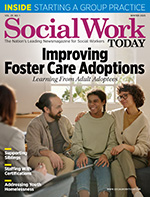|
Winter 2025 Issue Elder Abuse Training: The Evolution and Advancement of Elder Abuse Training Looking Out for a Critically Vulnerable Population While tremendous strides have been made over the years, elder abuse remains an ongoing concern for older adults and their loved ones. According to the National Institute on Aging, elder abuse can encompass physical, emotional, financial, and sexual abuse. But it can also mean neglect and abandonment. Elder abuse can happen in long term care settings but also in the home by family members, caregivers, or friends. It’s a complicated issue that demands a multifaceted approach. Elder abuse is a topic that Georgia J. Anetzberger, PhD, ACSW, FGSA, has been engaged in for nearly 50 years, giving her a long-range perception of its evolution. In fact, Anetzberger’s early research played a pivotal role in shaping practice and policy in the field of elder abuse before it was widely recognized as an issue. “I first came across this issue doing adult protective service work in 1974,” Anetzberger says. “But the recognition of elder abuse as a problem began in its broader form in 1975 as a result of Robert Butler’s book, Why Survive? Being Old in America, as well as two physicians in Great Britain who wrote short articles on the topic. I came in on the heels of that and have had the opportunity to see the field evolve. With that perspective, I can say that we have come a long way.” Making Waves She stresses that the most successful elder abuse training programs are those that combine resources from multiple experts. “The hallmark of elder abuse training would be a multidisciplinarian approach,” Anetzberger says. “The obvious discipline to include is social services—and this primarily falls on adult protective services—but you also need medical professionals, law enforcement, and legal experts involved, to name a few others. It is a multifaceted and complex issue that requires more than one discipline to weigh in.” Anetzberger says that a lot of assessment tools have also been developed, often for use in hospitals, long term care, and home care. But there remains no gold standard for elder abuse screening. And there is certainly a need for improvements to the abuse identification process, she adds. Research from the National Committee for the Prevention of Elder Abuse and the National Adult Protective Services Association shows that only 1.4% of cases reported to Adult Protective Services come from physicians. Practicing Prevention “Prevention training also remains an area that is not well-studied, and there is a need for more of it,” Anetzberger says. “However, I do feel that the future is looking hopeful in many ways. One of the interesting approaches that has recently received a lot of attention is the RISE Model out of the Elder Abuse Institute of Maine. This model is worth exploring for those looking at new ways to approach elder abuse.” RISE stands for Repair harm, Inspire change, Support connection, and Empower choice. According to the RISE website, RISE integrates methods used in other fields and adapts them to the unique challenges and circumstances of elder abuse. It is one of the first evidence-based programs dedicated to the prevention and response of elder abuse and self-neglect. Unlike a lot of other programs, the RISE model focuses on long-term support as opposed to short-term solutions. Currently, the work on elder abuse focuses on immediate intervention but not as much on long-term sustainability. “We place an emphasis on restoring and repairing relationships in the older adult’s life and developing their informal and formal social support networks,” the website says. Anetzberger says that a solution like this, which focuses more on prevention and also sustainability, could be transformative to the field. “I think the future is looking brighter,” she says. “We are undoubtedly moving in a positive direction.” — Lindsey Getz is an award-winning writer in Royersford, Pennsylvania. |


